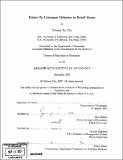Essays on consumer behavior in retail stores
Author(s)
Cho, Edward Ku
DownloadFull printable version (5.329Mb)
Other Contributors
Massachusetts Institute of Technology. Dept. of Economics.
Advisor
Sara Ellison and Duncan Simester.
Terms of use
Metadata
Show full item recordAbstract
This dissertation is a collection of three empirical essays in industrial organization using data from an anonymous retailer. All these chapters examine some facet of consumer behavior. The first chapter estimates demand for store and national brand over-the-counter pain relievers. There is evidence that the substitution patterns between store and national brands are starkly asymmetric- price cuts by national brands steal more share from store brands than store brand price cuts steal share from national brands. Another distinguishing characteristic between store and national brand products is that store brands can be found at only one retailer while national brands are found virtually anywhere. I find that an increase in the number of competing local retailers is associated with an increase (decrease) in store brand (national brand) share, which is consistent with the unique availability of store brands. In the second chapter, I investigate consumer inventory behavior and find that the increase in quantity resulting from a sale is in large part due to stockpiling motives. For example, using field experiment data, the estimated increase in consumption (net of stockpiling) is close to zero for the product categories mouthwash, diapers, and chocolate. I also identify a selection bias when one uses store-level data to estimate the impact of price on quantity. The third chapter evaluates the effectiveness of lowering prices versus just claiming prices are lower on demand, and how this relates to consumer price knowledge. Using a large-scale field test in which we varied both actual price (in the absence of any cue) and claimed price, we find that the response of these two effects is positively correlated. (cont.) A likely explanation for this positive correlation is that customers simply care more about the prices of some products than others. Also, customers respond more to low prices on items for which they have good price knowledge, but respond more to low price claims when their price knowledge is poor, although this is a second order effect.
Description
Thesis (Ph. D.)--Massachusetts Institute of Technology, Dept. of Economics, 2007. Includes bibliographical references.
Date issued
2007Department
Massachusetts Institute of Technology. Department of EconomicsPublisher
Massachusetts Institute of Technology
Keywords
Economics.